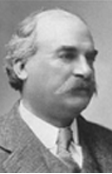- Robert Wood Johnson I
Infobox Person
name = Robert Wood Johnson I

image_size = 100px
caption =
birth_date =February 15 ,1845
birth_place =Carbondale, Pennsylvania
death_date =February 7 ,1910 (Aged 64)
death_place =New Brunswick, New Jersey
occupation =Businessman
spouse = Ellen Cutler
Evangeline Armstrong
parents = Sylvester Johnson III (1800-?)
Frances Louisa Wood (1810-?)
children = Roberta Johnson
John Seward Johnson I (1892–1983)
Robert Wood Johnson II (1893–1968)
Evangeline Johnson (1897–1990)Robert Wood Johnson I (
February 15 ,1845 –February 7 ,1910 ) was an Americanentrepreneur andIndustrialist . He was also one of the three brothers who foundedJohnson & Johnson .Birth
He was born in
Carbondale, Pennsylvania onFebruary 15 ,1845 to Sylvester Johnson III (1800–1882); and Frances Louisa Wood (1809–1881). He had the following siblings: Sylvester H. Johnson (1847–?); Mary Johnson; Anna Johnson (1825–?); Frances F. Johnson; Charles Cooper Johnson (1837–?); Louisa Johnson; Martha Johnson; William Hartley Johnson; Edward Mead Johnson (1852–?); and James Wood Johnson (1856–?).Early career
In 1861, Johnson accepted an apprenticeship in
Poughkeepsie, New York from his uncleJames Wood to work for the apothecary ofWood & Tittmer . This was a method to keep him from fighting in the Civil War. However, this was to become his training for a lifelong career. He later left Wood & Tittmer in 1864, to work inNew York City forRoushton & Aspinwall .Lister
While working for Rouston & Aspinwall, Johnson met
George J. Seabury and they decided to leave the firm and go into business together under the name ofSeabury & Johnson . Both Seabury and Johnson were interested inJoseph Lister 's discoveries and tried to make products that would assist in the surgery room. Johnson worked 12 hour days to try to invent aseptic surgery equipment. By 1878, the firm was making $10,000 a month (or in 2006 dollars $214,000.)Both Seabury and Johnson could not agree on how to distribute the profits of the firm. Seabury also did not approve Johnson having his younger brother, James Wood Johnson, in the firm. In 1880, Johnson sold his shares of the firm to Seabury, and he agreed to not go into the medical business for 10 years.
Johnson & Johnson
Johnson's other brothers James Wood Johnson and Edward Mead Johnson both wanted to start a business. The new firm would do business under the name of Johnson & Johnson. However, the firm was struggling to stay afloat, it did not have the capital sufficient for a startup company.
While the Johnson brothers were going at it alone, Seabury was trying but unable to pay Robert Johnson his monthly payment that had been agreed upon when he left the partnership. Therefore, Seabury agreed to let Johnson reenter the medical field if he, Seabury, did not have to continue paying Johnson his monthly installments. Then John decided to join his brothers' firm and provide the needed capital to give the business a fresh start.
The new partnership agreed to give Johnson half of the company's shares in return for management of the company. Brothers James and Edward would receive thirty percent of the company.
Johnson worked all hours of the day going back and forth from the factory in
New Brunswick, NJ to the office in New York and by early 1888, J&J was making $25,000 a month.Kilmer
Dr.
Fred B. Kilmer owned a local pharmacy inNew Brunswick, New Jersey . Johnson met Kilmer in early 1887, and they developed a lifelong friendship. After meeting Johnson, Kilmer became more involved in J&J. He eventually became an employee and he would introduce one of the first medical research laboratories.Kilmer was responsible for making many of the innovations in sterilized dressings. The first marketing items Kilmer introduced were medical manuals, guides for how to react when injured on board trains, such as when feet are squashed or when legs are broken at train stations or depots.
In time, Kilmer would influence most of America with his new products. By the late 19th century, railroads had taken most of the nation by storm. There was no practical way to heal at train depots. He decided to introduce his idea of first-aid kits. The Red Cross symbol became as common as the Bald Eagle. Soon, people believed that the first-aid kits were as important to their daily lives as railroads, light bulbs, and family. It became an American way of life to grab a first-aid kit when in need of help.
In 1890, upon receiving a letter from a colleague asking advice on how to treat a skin irritation on one of his patients. The patient had used medicated plasters and it was assumed that the plaster caused the irritation. Kilmer sent him a small tin of Italian
talc . With the success of this treatment, J&J started including containers of talc with its plasters.Marriage and children
He married Ellen Cutler in 1880 and had a single child:
*Roberta Johnson He then married Evangeline Armstrong and had the following children:
*John Seward Johnson I (1892–1983)
*Robert Wood Johnson II (1893–1968)
*Evangeline Johnson (1897–1990)External links
* [http://www.jnj.com/our_company/history/history_section_1.htm;jsessionid=FREPABN2HGP3OCQPCAOWU3YKB2IIWTT1 J&J corporate history]
Wikimedia Foundation. 2010.
